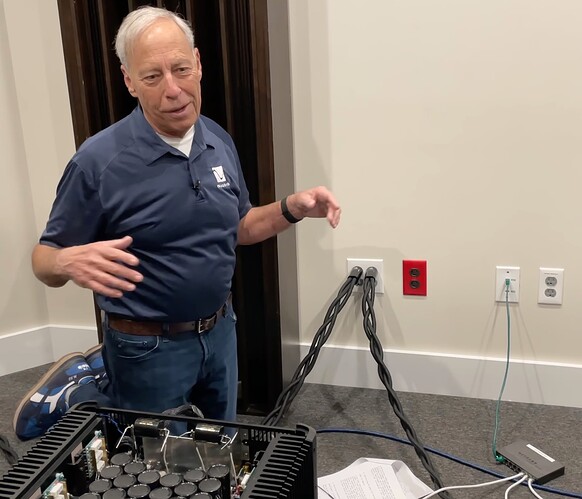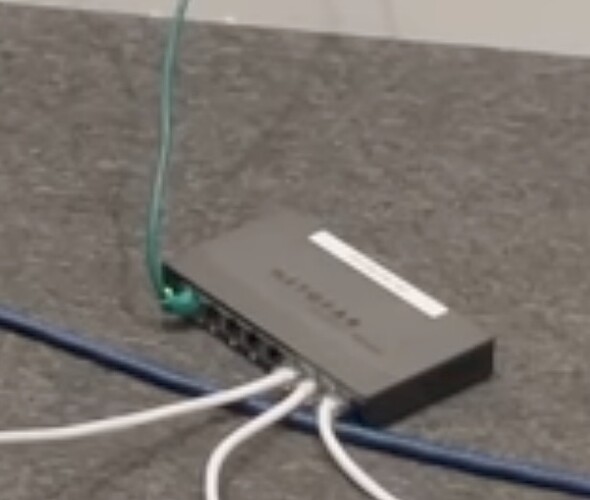I’ll bring the music.
All the ‘action’ is over on the Ethernet cable thread 
Think about it logically… Approx. 5-10km of cable coming from a local substation at 240v single phase. hundreds of meters of 2.5mm cheap-as-chips twin and earth, literally running rings around your home and hi-fi setup. Then you add 1m of super-duper special cable born of angels dust which uses plugs made of copper purer than virgin Mary and hey presto all the dirt behind it is suddenly corrected…
go figure
You absolutely don’t need to demo a Audioquest Diamond to experience the considerable difference. A NRG-Z3 or of course the higher it gets even more obvious. Braided ones like the Thunder, Tornado, Hurricane etc are really exciting to demo once you get the chance.
In the land of audiophoolia, science and logic be damned!
Interesting to see that he’s using a Netgear switch.
Clearly audiophile power cables trump audiophile networking gear ![]()
I don’t even know why I watched this, but I did… and to me, Paul’s explanation about why braiding works for power cables makes absolutely no sense. He says that braiding reduces inductance, which filters out high frequencies. Soooo, we braid power cables to let high frequency noise go through??
 He even admitted they’re using non-braided interconnects. I guess there was no money left after buying the power cables.
He even admitted they’re using non-braided interconnects. I guess there was no money left after buying the power cables.
Just an thought about the fact that the power cords may have a function: In France, we have electricity meters called Linky which, via PLC, continuously send readings to the Central. These PLC’s create audible noise in my speakers, so this morning I installed a special filter at the base of the outside power cord. And, I don’t hear these parasites anymore… after 25 km of external power cable, before arriving… at the last meter to the amplifier. Just an thought.
£4K for a 1m cable, almost £16K for 5m. Those sort of prices make the optional ‘SR Purple’ fuse upgrade look like a real bargain at only £190 ![]()
From their website:
“moving up in the Storm series delivers a greater degree of improvements, such as; enhanced dynamics, reduced noise-floor, punchier bass, larger spacial presentation, greater air movement, less fatiguing sounds & clearer clarity.”
I definitely need some clearer clarity in my life. As they state “Words are meaningless once you’ve heard the difference and simply know the truth” ![]()
Paul’s actually not right on this one, and there’s even mention to that in the comments section of the video, but without much resonance by the other contributors - this is just ridiculous!
Explanation is, that inductance is actually reduced by closely spacing the conductors in an interconnect, better yet tightly twisting them, since the opposing magnetic fields of the conductors then better cancel each other out.
Applying the mathematically proven laws of physics would help greatly here - still shaking my head!
Whatever anyone using these cables hears, it’s not caused by the reduction of inductance…
BTW, tightly spacing conductors in cables reduces inductance but comes at the penalty of raising cpacitance.
These intrinsic cable R-C-L components need to be seen in relation to source and sink impedance, meaning that:
- With the low impedances involved in speaker level connections, you’d want to reduce inductance, since it can do harm at audio frequencies as cable length gets large.
- With the high impedances involved in line level cables, you’d want to reduce capacitance, since it can do harm at audio frequencies as cable length gets large.
Funnily, many high priced exotic interconnect constructions exhibit counterproductive electrical properties, thus excessively tailoring the overall frequency response and thereby sometimes ameliorating speaker/room response problems - et voilà, the improved listening impressions might well be correct in that situation!
Of course one would be better advised to understand and fix the underlying problem - usually at less net cost…
Paul’s not right in general if you ask me. I watched a video of him some time ago explaining why the PSAudio DirectStream DAC was better than an ESS DAC chip. He was showing the block diagram of their DAC side by side with ESS’s to demonstrate how much simpler their DAC was compared to the very complex DSP in the ESS chip. There were indeed a lot fewer boxes in the DirectStream diagram; problem was, the biggest one was labeled “FPGA”.
This is the same DAC that achieved a measly 75.5dB SINAD and on a multitone test could only manage 10 bits of distortion free range. Whilst most good ESS DAC chip implementations achievce nigh on SoTA performance.
I don’t care how much some people say they love the sound - as a D/A converter implementation, it’s verging on broken…
Let’s stick to power cables, guys!

I’m sorry but you must imagine the difference since Roon forum engineers and specialists say so.
This is a perfect example of how measurements don’t correlate with what people actually prefer and want to hear. PSAudio DS is very popular and liked DAC.
There was me thinking the equipment power supply was designed to supply clean low voltage from the high voltage mains?
If you have issues, surely this is the place to investigate and quality equipment should have this design sorted out by now… I’m not sure what changing a cable can do but in my case, Meridian have never tried to sell me a cable to enhance the performance of their DSP speakers, and I don’t feel the need to buy any…
Yes, and people who own it claim they can sonic improvements from power cables, ethernet cables, switches, fibre converters etc.when quite clearly if a change was significant enough to raise it’s head above a noise floor that only allows 76dB SINAD, it would be clearly measurable.
Or then we just don’t know how or what to measure yet. Power cables and power strips have clear effect in my system. My Linn streamer/dac/preamp is quite immune and I currently use the stock kettle lead on it but the ATC actives clearly benefit from something higher of quality than the stock kettle lead. Linn uses their Dynamik SMPS in Akurate DSM. But it’s useless to get into this debate anymore. We’ve done it dozen times already.
Btw. Do you believe in differences between analog interconnect cables or XLR vs RCA? Here’s an interesting paper about the subject:
http://boson.physics.sc.edu/~kunchur/papers/Audibility-of-cable-pathways--Kunchur.pdf
There’s something about psychoachoustics and blind testing also. Goes offtopic though, sorry about that.


